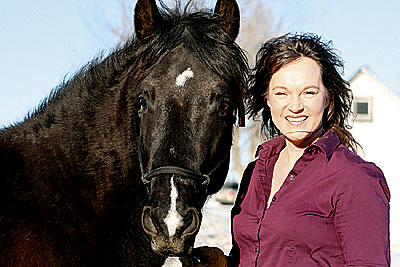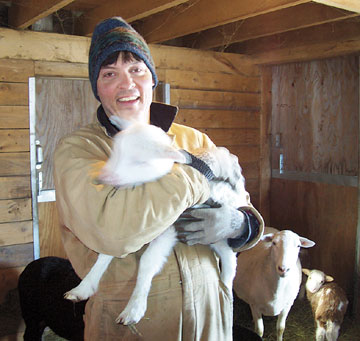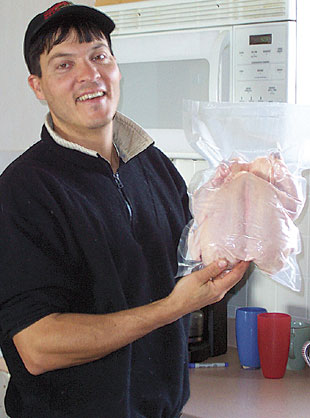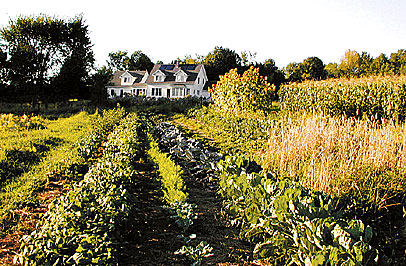 |
| Karina Lewis and Kirk Stanley own Lake View Farm in Harmony, where, among other things, they raise and place wild mustang horses, such as Mickey, who came from a Nevada band of horses. Photo by Lisa McAllister. |
Career Changers Part of the Burst
by Jo Anne Bander
On a frigid mid-March morning, with their Maine farm still snow-covered, Sarah and Richard Harrison were concerned about the condition of their 15 beds of garlic. They are not unique to seasonal angst, but this garlic is their first commercial crop.
The Harrisons are typical of the growing number of career changing new farmers populating small farms in Maine. Career changers, usually in their 40s and 50s, bring to the farm expertise from careers in teaching, business and even medicine as well as the financial assets they generated – but not necessarily farm experience.
The Career Changer Profile
Judith Gillan, director of the Massachusetts-based New England Small Farm Institute (NESFI), finds career changers drawn to courses such as Exploring the Small Farm Dream. “They tend to be value driven and often close to retirement,” she observes, “often someone who has been a service provider, maybe a teacher, and who now wants to move from care-giving people to care-giving land and animals.”
Kathryn Hayes, who developed the Exploring course, teaches the course and train-the-trainer workshops in other states and Canada. Its decision-making focus pushes participants to critically analyze earned income expectations and not to expect high net income.
 |
| Kirk Stanley with one of Harmony Farm’s lambs. Photo by Karina Lewis. |
 |
| Stanley with one of his farm-raised chickens. Photo by Karina Lewis. |
A potential drop in income works for many career changers: Hayes finds that “more than high income, they want lifestyle change. They bring to farming varied work or life experience that younger people often don’t have. This can include experience in marketing, financial management…or running a business.”
Maine Observations
Andrew Marshall, MOFGA’s educational programs director, portrays Maine’s career-change farmers as individuals who “went into their first career with financial motivation and into farming as a lifestyle choice.” They populate MOFGA’s daylong gardening and farming workshops and the annual Farmer to Farmer Conference.
Career changers keep Tori Jackson, Extension Educator for Androscoggin and Sagadahoc Counties, busy. They typically call when “they have already settled in Maine and have land they are considering putting into production. They want to know if it’s possible, what to grow and if they can make a living.”
Jackson responds with questions and then a two- or three-hour meeting with a questionnaire that explores goals, the need to derive full income from farming, prior agricultural experience, nature of off-farm income and health insurance.
Fitting the Profile
Susan Straubing, a retired elementary school teacher, was struck by farm lightning in 2001 as she turned 50. She signed up for a master gardening class and apprenticed with Deb Soule at Avena Botanicals.
By 2003, Straubing and her husband, Sandy Bolster, had moved from their lakeside home in Lincolnville to an 11.5-acre parcel on Morgan Bay in Surry. They began their Morgan Bay Farm from scratch, enriching their acidic, heavy clay soil with compost and lime, bringing an acre into cultivation.
Influenced by Avena’s medicinal herbs and alternative health products, they initially planted lavender, other herbs and elderberries but are shifting their emphasis to vegetable production to increase income and because “while herbs are great, if you don’t have good food, you don’t have good health.” They sell a mix of organic vegetables. Their mixed lettuce, which they wash, spin and bag, and strawberries and raspberries generate the highest return for ground and labor invested.
They turn elderberries into jam; wine for personal consumption (although they could legally sell up to 100 bottles); and tincture and syrup for medicinal use. They await fruit from their peach and apple trees to expand their fresh farm product line.
Straubing and Bolster began their self-financed farm without a business plan or budget and projected several years to make a profit. The first three years they sold from their own farm stand, supplementing their offerings with eggs and dairy from a neighboring farm.
Now profitable, Straubing recognizes the need to keep better records and is taking business and marketing seminars. They are also looking at selling value-added products such as maple syrup and the elderberry wine.
Sue and George Sergeant of Patchwork Gardens in Brunswick are “more gardeners with animals than farmers,” but they have learned how much 1 acre of their 9-acre farm can produce by planting intensely, composting and rotating crops rapidly.
Gardeners for some 25 years, they transitioned to full time in the late ‘80s when Sue retired from teaching and from working at Chewonki Foundation. George retired from teaching in 2000 and joined her. Their cash cow is their pre-washed, bagged salad greens, with a long season and high return, containing Sue’s signature Johnny jump-ups and sold at the Brunswick Farmers’ Market.
Highbush blueberries, garlic, tomatoes and other produce round out their seasonal offerings. Value-added products include George’s jams, jellies, pickles, dilly beans and salsas, while Sue turns yarn from her angora goat and others’ sheep into knitted hats; sells yarn; and makes potholders.
Farming represents about a quarter of their income, but a critical quarter. They are staying at that scale, partly to minimize bookkeeping and recordkeeping. Sue finds that “at the farmers’ market you are teaching all the time,” and she stocks seeds and other farm “touchables” to show when school groups visit the market.
 |
| The Knapps’ vegetable garden in Farmington. Photo courtesy of Burt Knapp. |
From Teaching Nutrition to Providing Nutrition
Retiring physicians Nancy and Burton Knapp moved from full-time medical practices near Portland to a 19th century farm in Farmington in August 2007, planning to gradually begin vegetable farming. Internist Nancy has always discussed nutrition with her patients.
She has grown the couple’s own food, a practice she inherited from her father. She and family practitioner Burt are farming to share “our love and passion for good food and eating well with other people.”
On their Porter Hill Farm – 30 acres of pasture and 140 of woods – they raise vegetables and chickens. In the summer of 2008, their first production season, they cultivated about 1/4 acre. Their small CSA provided several families with seasonal vegetables from mid-June through September. Bountiful fall crops led the Knapps to extend the CSA until the first weekend in November. They sold eggs when they had excess.
The Knapps are adapting the mix and quantities of vegetables to customer preference and are keeping their growth to about a dozen families for 2009. Excess food will go to a small farm stand and leftovers to a local food pantry.
Nancy says farming today is “more of a science, and tackling it from that perspective makes it interesting and challenging. The fact that we understand nutrition means that talk about potassium and phosphorous in the soil makes sense.”
They are considering producing maple syrup commercially and are prepared – if demand exists and if they can find help – to grow, maybe into a mid-sized CSA with a young couple to run and eventually take over the operation.
What the Census Numbers Show
James McConnon, Extension Specialist and Professor of Economics at the University of Maine, in studying the 2007 USDA Agricultural Census, is substantiating his own observations and those of colleagues regarding ages of new farmers, career changers, farm size and moves to direct sales.
The number of Maine farms has increased by 13.1 percent – from 7,196 in 2002 to 8,136 in 2007. Mean farm size declined from 190 acres in 2002 to 166 in 2007. Most of the growth in numbers is in the smaller farm size category – about 70 percent in farms between 1 and 49 acres. The number of large farms – 180 acres and above – declined from 1911 to 1688. The number of farms with 50 to 179 acres continues to grow, but not as rapidly as smaller farms.
The product mix relative to market value of sales has shifted, with crops contributing 52.9 percent of total farm value in 2007 compared with 47.9 percent in 2002, and livestock/poultry declining from 52.1 to 47.1 percent. The 2007 numbers indicate an 11.1 percent decline in full-time farmers – the principal operator who spends no working time off farm – while the principal operator age increased from 53.7 years in 2002 to 56.4 years in 2007. Two hundred more farms have a principal operator age 55 to 64 and 229 more have one age 65-plus.
Simultaneously, smaller farms are doing more direct marketing, substantiated by a significant increase in the value of agricultural products sold directly to consumers through farmers’ market, CSAs and farm stands. These sales increased 63.9 percent, from $11.2 million to $18.4 million, with a mean increase in direct sales per farm of 39.7 percent, from $7,729 to $10,803.
The Business of Career Change Farms
John Harker, Agricultural Resource Management Coordinator for the Maine Department of Agriculture, Food and Rural Resources, regularly gets calls from career changers. He urges them to take a business planning class, connect with financial resources, start market research – and “not to spend their hard earned cash until they know they can make a profit at what they are attempting.”
Kathy and Liam Trodden searched Maine, a favorite vacation destination, to find their 1850s, 57-acre Second Chance Farm in 2001 in Avon. Long established on Nantucket, Kathy with her 20-plus years of catering experience and Liam, a carpenter who had grown up on a farm in Ireland, were ready to combine her love of cooking with his passion for organic farming.
Drawn to raising animals and making quality cheeses, they focused on niche organic foods. After their 2004 move to Maine, they enrolled in Harker’s business planning course and sought help from Vermont’s Peter Dixon of Dairy Foods Consulting to learn to make cheese.
With savings and proceeds from selling their home on Nantucket, they jumped into developing the farm; obtaining MOFGA certification; and building their stock. Today their grass-based farm produces beef, veal, heritage pork, farmstead cheese, raw milk, fiddleheads (in season), maple syrup and baked goods, as well as a variety of farmstead artisan cheeses and other dairy products. Using milk from their goats and cows, their cheese bears the names of nearby mountain peaks – Bigelow Blue and Tumbledown Tomme.
Last year they broke even after two full years of production, but they are still refining their products and process, abandoning their Longfellow’s Serenade cheddar in favor of a unique buttery cheddar and blue cheese combination. They sell direct from the farm; to Whole Foods in Portland and to select health food stores; at the Sandy River Farmers’ Market; and to restaurants, with some winter cheese sales through the Crown O’ Maine Organic Co-op and meat sales from their freezer.
Kathy measures compensation not just by money but by appreciating “how wonderful and warm the animals are, how much people appreciate our food and finding every day different, every day a surprise.”
Year One
The Harrisons, both 70, are food activists and consumers – founders in Marblehead, Mass., some 17 years ago of the Farm Direct Coop, with 640 shares this season, and founding members 12 years ago of the Marblehead Farmers’ Market. In 2004, concerned about economic collapse, they sought Maine farmland where they could be part of the solution by leveraging their business skills and gardening expertise into growing healthy food for themselves and others.
In late 2004 they purchased 52 acres in Montville that had been farmed since 1813, 32 acres in open fields, without buildings, water or electricity – now True North Farms. Jason Glick and Jen Bruce had been renting and cultivating about 3 acres there, which they had already gotten certified by MOFGA and which they continued to farm through the 2007 season.
Retired from running an Internet company, Harrison has attempted to adequately capitalize the farm and has incorporated it. The Harrisons had grown garlic for 20 years for personal use and recognized it as a high value crop that stores easily and that was suited to Internet sales.
Concerns about potential garlic diseases have them diversifying to mixed vegetables, which they will sell this season at the Augusta Farmers’ Market and Common Ground Fair.
With two new barns on the property, but still living in two small, non-winterized cabins, Richard is collecting small-scale farm equipment for bed making, cover cropping and garlic mulching. He purchased a grain drill on eBay, and bought a sickle bar mower and hay baler. While they plan to continue to winter in Marblehead, Sarah has changed her listing in the town’s annual census – to farmer.
A Few Steps Ahead
After working in the mental health field and learning to farm in the mid-Atlantic states, Richard Frost returned to Maine when his wife, Cindy, took a nurse practitioner position here. They settled in Alfred in 2003. While working with a shelter program in York, Frost farm shopped until, in 2005, he purchased 20 acres in Liberty – 4 open and 16 wooded – for their Frost Family Farm. His vision: full-time, sustainable farming focused mostly on berries and perennials, and with a small orchard – but starting with some annuals.
Frost was interested in fruits from the beginning as a direct sale item and later as a source of value added products, as well as possible medicinal crops. The wooded area will provide materials for his woodworking with potential for later mushroom farming.
Frost is on plan but recognizes that it takes a couple of years on a specific property to understand its potential and micro-climates. In 2006 he started growing and by 2007 was selling annuals, moving to some raspberries and strawberries in 2008. This year he expects some blueberries.
Life experience has made Frost understand the importance of working cooperatively, building a network of small farmers and developing his community. He is helping start the Liberty Farmers’ Market and is an informal consultant to start-ups like the Harrisons. By the time Cindy retires, Richard expects adequate farm income to provide the budgeted add-on to retirement savings.
Starting with a Big Vision
When Karina L. Lewis and Kirk Stanley met in Colorado, cattle ranch-raised Lewis was working full time as an equine clinician; Maine-raised Stanley was running Soothsoft Innovations (www.chillow.com), the company he had developed. They moved to Maine to fulfill Lewis’ lifetime dream of owning her own ranch and his desire to farm.
After searching from 2005 to 2007, they found their dream: Lake View Farm in Harmony – 400-plus acres, 90 of which are tillable in pasture, on Great Moose Lake – and settled for a lease with an option to buy. Upon arrival that September, they started getting to know the property and its potential – and developing a 52-page business plan.
They purchased two oxen teams, which, combined with the wild mustang horses they raise and place (Lewis is the only approved trainer in Maine for the Bureau of Land Management and The Mustang Heritage Foundation), allowed them to power with animals. They began to build their herds and flocks, selecting Katahdin sheep, a Maine native, and turkeys, chickens and bottle calves. They follow sustainable organic practices and use rotational grazing.
By word-of-mouth advertising, they sold their complete 2008 production – 14 head of cattle, some 25 turkeys, 250 chickens, two pigs and half a dozen sheep. They are expanding in 2009. Their farrier business, providing natural hoof care and maintenance, provides steady and expandable income. They also sell bread from their wood-fired oven to their farrier customers and others.
They are taking a long-term approach, focused on building an identity for their products under the Baroness brand. Thinking even bigger, they are developing their own Martha Stewart-type TV show on family farming. At 39 (Lewis) and 42 (Stanley), they have the energy and time horizon to build big.
Into The Future
Career-change farmers are developing farms and businesses throughout Maine that are expanding the supply of quality, local, sustainably grown food and value-added products. They have come online when, in Straubing’s words, “we cannot grow enough to supply everyone as everyone gets more educated about good, local, nutritional food.” Whether full-time farmers with business plans to bring them to large scale, or part-timers enjoying their mature years living off the land and having the joy of growing good food for others, they, their customers and Maine are all benefiting.
